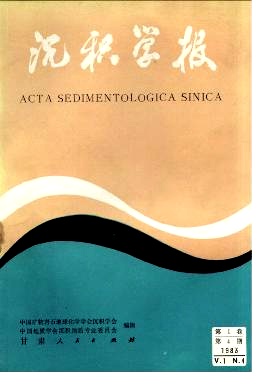INTERPRETING ECOLOGIC ENVIRONMENT OF FORAMINIFERA FROM THE CARBONATE MICROFACIES OF PERMIAN IN WESTERN HUBEI
- Received Date: 1982-09-23
- Publish Date: 1983-12-10
Abstract: The Permian carbonate rocks are widespread in western Hubei.Apart from some clastic rocks at the bottom of Qixia Formation or at the top of Maokou Formation.most of them are carbonate deposits in ichich abundant foraminifears can be found。According to the origin一textural types carbonate rocks.indee of cater energy,and other biological assemblages associated with benthos foraminifera.the carbonate rocks can be subdivided into the folloivind 6 types of fades as well as 10 types of microfacies(Fig. I):a.Deep shelf It includes 3 types of microfacies(Plate 1,2).This facies is rich in argillo-calcareous composition and small bioclasts kith pelagic fauna,e.g.ammonite,sponge-spiculite.Algae are scarce.Among foraminifersa.the type of deep vrater such as iguiella.Palaeofusulina. Codonofusiella(P2),and Schwagerina,Chusenlla,Rugos-oschwagerina(P21),are predominant.b.Near shore shelf It contains 3 types of microfacics(Plate. 3).Sedimentary property and fossil assemblage show a lowtide open sea area near shore. There appear abundant green algae(Dasycladaceae).Adaptable fusulina such as Nankinella, Pisolina,Splraeru-lina and Verbeekina, as well as non-fusuline foraminiferas such as Pachyphloia,Padangia, Cribrogenerina, Climaeammia and so on.c.Tide shoal The type of rock is pelsparite(Plate 4,5)with red algae and green algae.This facies is formed in a lowtide high-energy and shallow water belt with normal salinity Fusulina specially thrive on,such as Yabeina Neosrhwagerina, Colania,Sumatrina, Pseudoliolina,Yerbeekinaand so on.Non-fusuline foraminiferas,Pachy-phloia,Cribrogerrerirra. Clinracammina and Nodosario are the most.d.Algal mud mound Algal limestone and micrite algal limestone are common types of carbonate rocks(Plate 7).Red algal Gymnorodiareae is well developed,while foraminifera has seldom grown to a thrifty colony·in whick a few of.Nankinella of Staffellidae are representative in early Lower Permian,and the genus of Srhwagerina arc abun-dant in Late Permian.Codonojusiella flourish in the Upper Permian.e.Intertidal flat The phyloid algal limestone is a representative of this facie (Plate 6).Nankin-ella is an adaptable fusulina to ecologic environment and becomes more prevalent.Non-fusuline foraminiferas including Eolasiodiscus, Glomospira and Nodosaria are the most abundant,the nest is Padangia. f.Restricted lagoon The rock type is silty micrite(Plate,8).The fossils consist of fragmental and scattered ostracodes,brachiopodas,bryozoans as well as Tubiphyfes,Vermiporella and Osagia. The species of non-fusulina or fusulina is simple,in which Padangia Perforata Lange are specially abundant. Only few Nankinella can be formed,which belongs to fusulina.The ecologic environment of foraminiferas is interpreted bt- means of studying on Permian carbonate microfacies and analysing their own architecture and morphologic function in this area.It is suggested that the foraminifera of Permian has not only obvious succession on vertical section,but is sensitive to living environment as well.There appear different units of foraminifera to various environments.
| Citation: | Yang Zhenqiang, Lin Jiaxing. INTERPRETING ECOLOGIC ENVIRONMENT OF FORAMINIFERA FROM THE CARBONATE MICROFACIES OF PERMIAN IN WESTERN HUBEI[J]. Acta Sedimentologica Sinica, 1983, 1(4): 93-105. |






 DownLoad:
DownLoad: